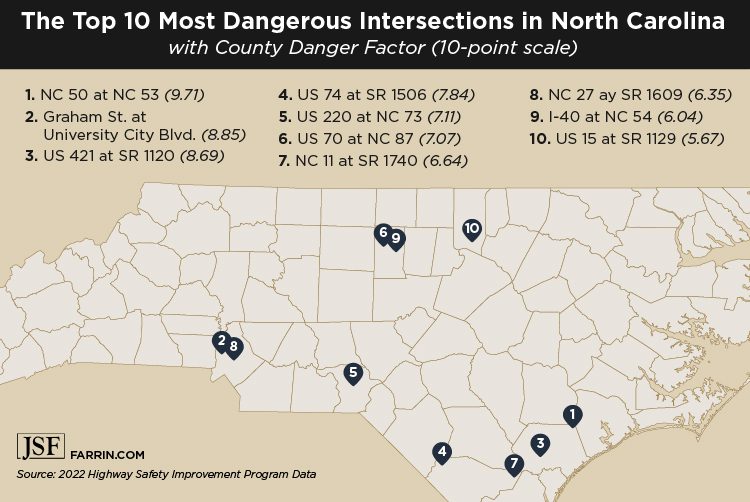It is a Monday morning. Everyone is coming off the weekend – some are eager to start the week, speeding along. Others are overtired and distracted, not quite giving their full attention to the road. Some are running late, rushing and careless. All of these scenarios have the potential to lead to the same result: a car accident.
While distracted, fatigued, or careless drivers are bad enough, there are intersections that pose a statistically higher risk as well.
Intersections are naturally a high-risk area and, as the statistics show, some intersections are worse than others. According to the Federal Highway Administration (FHWA), more than 50 percent of the combined total of fatal and injury crashes occur at or near intersections. And, according to 2020 crash statistics from the North Carolina Department of Transportation, nearly half of all crashes across the state happened at intersections. While more than 120,000 crashes happened at non-intersections, nearly 115,000 happened at intersections.
The biggest culprit? Almost 40,000 of intersection crashes happened at intersections with no traffic control device whatsoever. A close second was the more than 38,000 crashes that happened at stop and go signals. The third most likely traffic control tool to be a factor in a crash is the standard stop sign.
As such, drivers should take note of the most dangerous intersections in North Carolina.
The Top 10 Most Dangerous Intersections in North Carolina
Based on the 2022 HSIP data, the most potentially hazardous intersections in North Carolina are as follows:
| Rank | Intersection | County | Danger Factor (10-point scale) |
|---|---|---|---|
| 1 | NC 50 at NC 53 | Pender | 9.71 |
| 2 | Graham at University City | Mecklenburg | 8.85 |
| 3 | US 421 at SR 1120 | Pender | 8.69 |
| 4 | US 74 at SR 1506 | Columbus | 7.84 |
| 5 | US 220 at NC 73 | Richmond | 7.11 |
| 6 | US 70 at NC 87 | Alamance | 7.07 |
| 7 | NC 11 at SR 1740 | Columbus | 6.64 |
| 8 | NC 27 at SR 1609 | Mecklenburg | 6.25 |
| 9 | I 40 at NC 54 | Alamance | 6.04 |
| 10 | US 15 at SR 1129 | Granville | 5.67 |
Highway Safety Program and its Initiative to Help Drivers Stay Safe
The North Carolina Department of Transportation (NCDOT) pioneered the Highway Safety Improvement Program (HSIP) to provide precisely this type of data, with the hope of “addressing specific traffic safety concerns throughout the state.”
Through HISP, NCDOT compiled the above data from the potentially hazardous intersection locations in each county. From that, we gathered the 10 most dangerous intersections overall across the state. While this data reflects where crashes are occurring, we are still left with one glaring question: why?
Factors Contributing to Intersection Crashes
The most frequent reasons (in order from most prevalent to least) were inattentive driving, making a false assumption of other’s action, turning with an obstructed view, performing an illegal maneuver, distraction, and misjudgment of other’s speed. As such, exercising safe, attentive driving is critical.
The study also found the following characteristics to be particularly distinguishable:
- Age: Specific driving errors were most commonly found in certain age groups. For example, intersection crashes involving those 24 and younger are most often attributed to distraction, false assumption of other’s action, or aggressive driving. Crashes involving drivers ranging in age from 25-54, on the other hand, are likely due to physical impairment (for example: sleeping, heart attack, etc.), illegal maneuvers, inattention and aggressive driving. Finally, crashes involving drivers 55 and older are often caused by inattentive driving and misjudgment of other’s speed.
- Gender: 1% of crashes involving female drivers were at intersections, while 32.2% of crashes involving male drivers were at intersections. Furthermore, intersection crashes involving female drivers are often attributed to inattention and internal or external distractions. In contrast, crashes involving male drivers are most likely caused by illegal maneuvers, aggressive driving, or physical impairment.
North Carolina Car Accident Lawyers
If you find yourself in a car accident – anywhere in North Carolina, intersection or not – The Law Offices of James Scott Farrin is ready to help you. We will evaluate your case for free, and we do not collect an attorney’s fee unless we get compensation for you.2
If you have been in an auto accident in North Carolina, contact us or call 1-866-900-7078.
You May Also Be Interested In
Answers to the Most Frequent and Urgent Car Accident Injury Questions
NC Highway Ranks As a “Top 10 Most Dangerous Road”
Driver’s Guide to the Most Dangerous Intersections in the Raleigh-Durham-Chapel Hill Triangle




